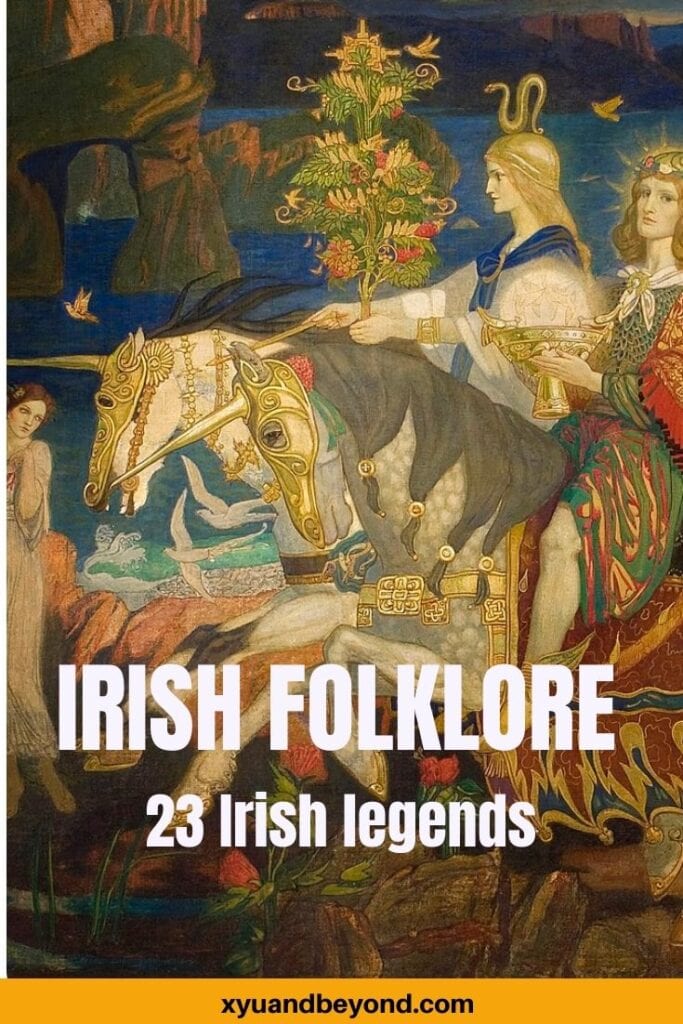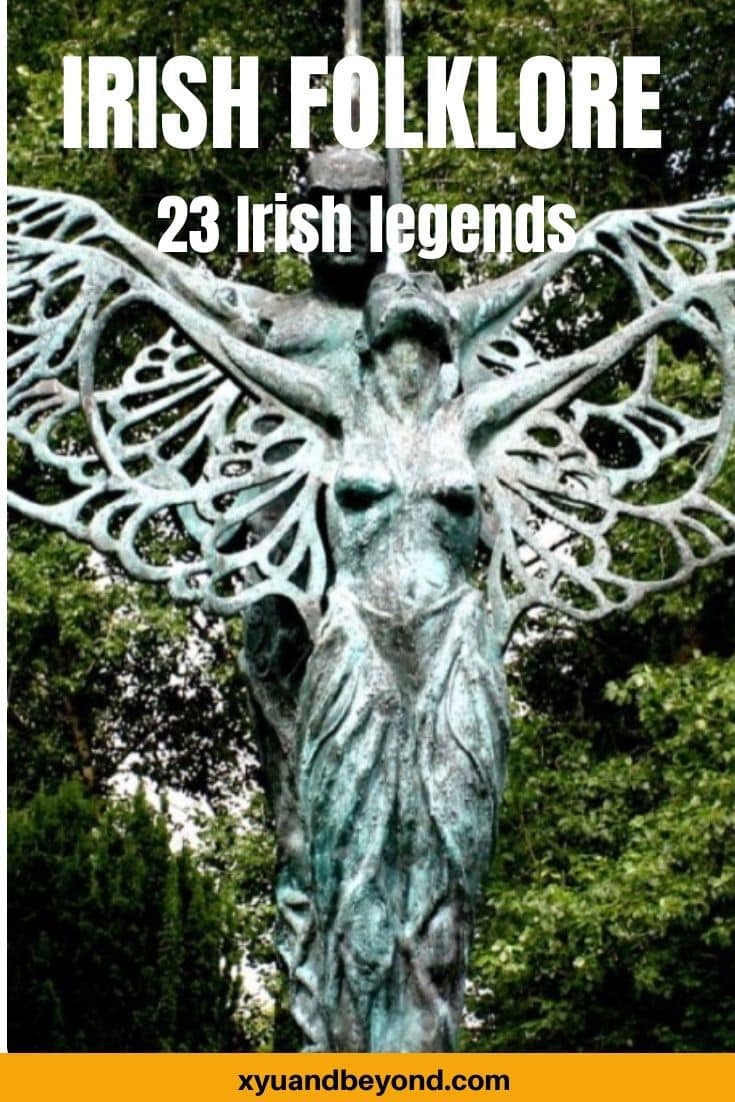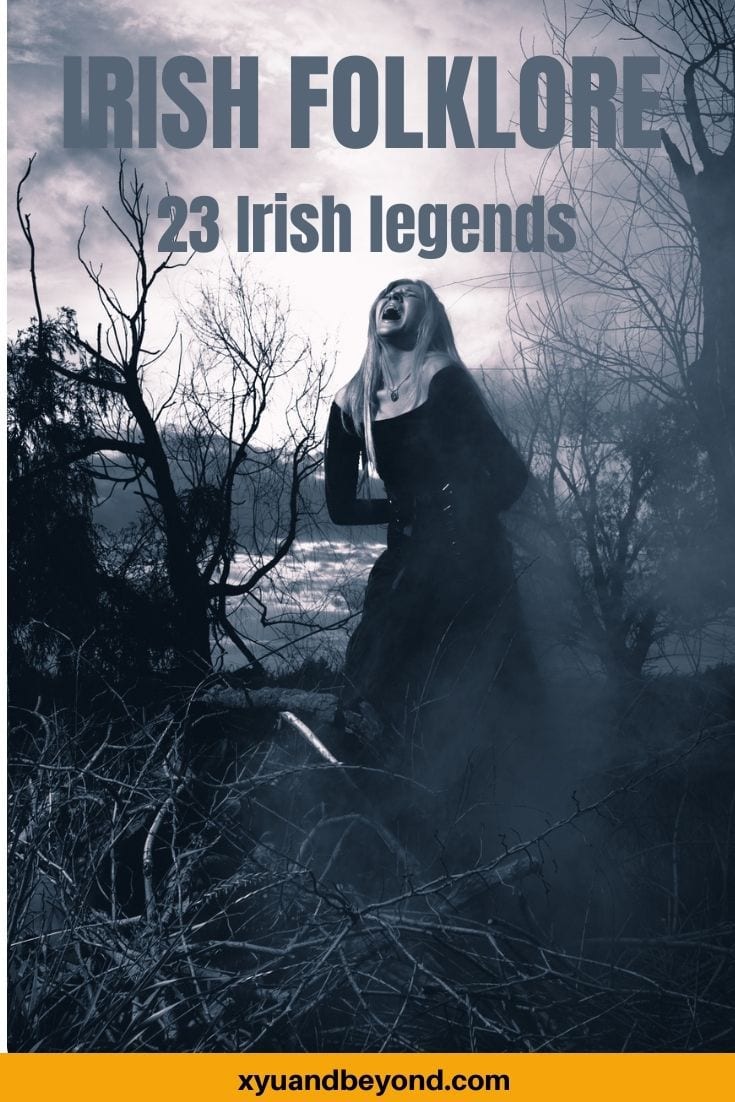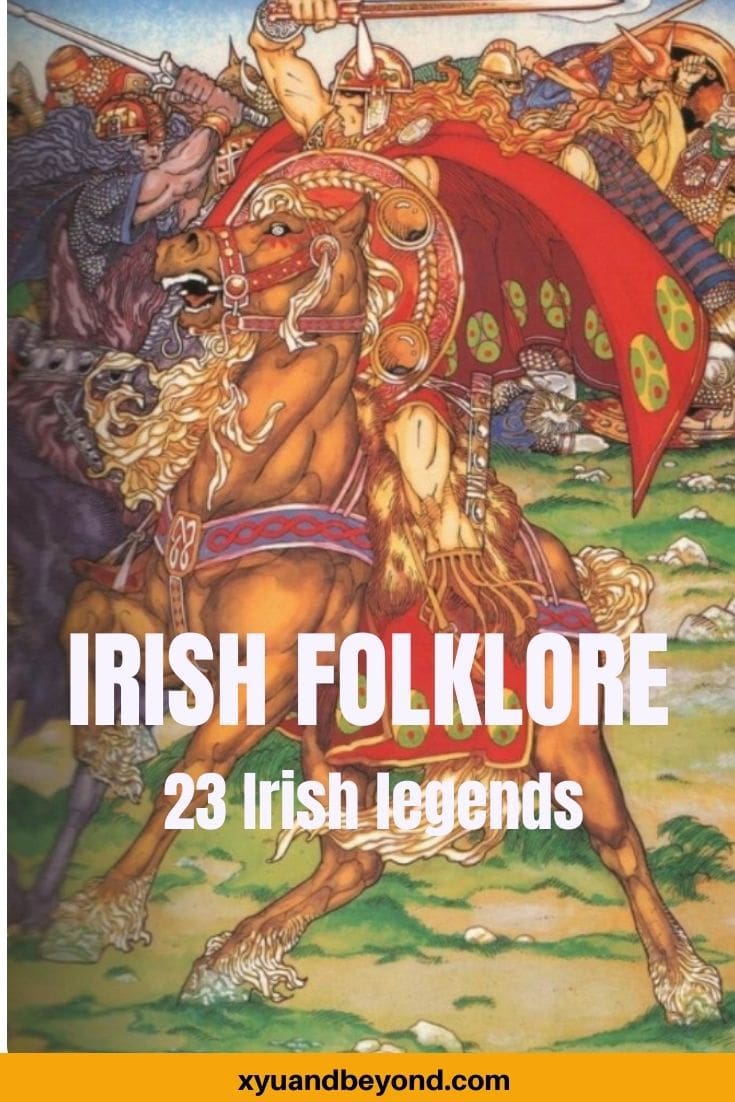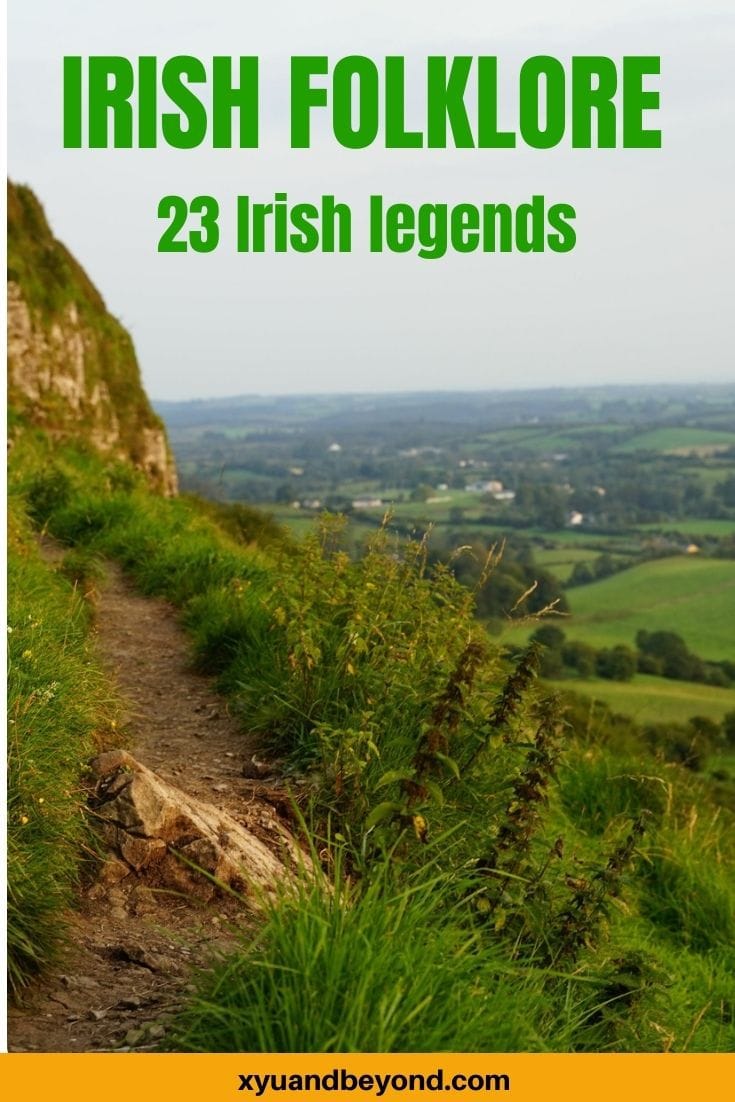Irish Folklore: 23 Irish legends and myths
Irish myths and legends are known worldwide. Fairies, leprechauns, banshees the ancient Sidhe the Tuatha de Danaan and old Irish tales have been used throughout pop culture from movies to fantasy novels.
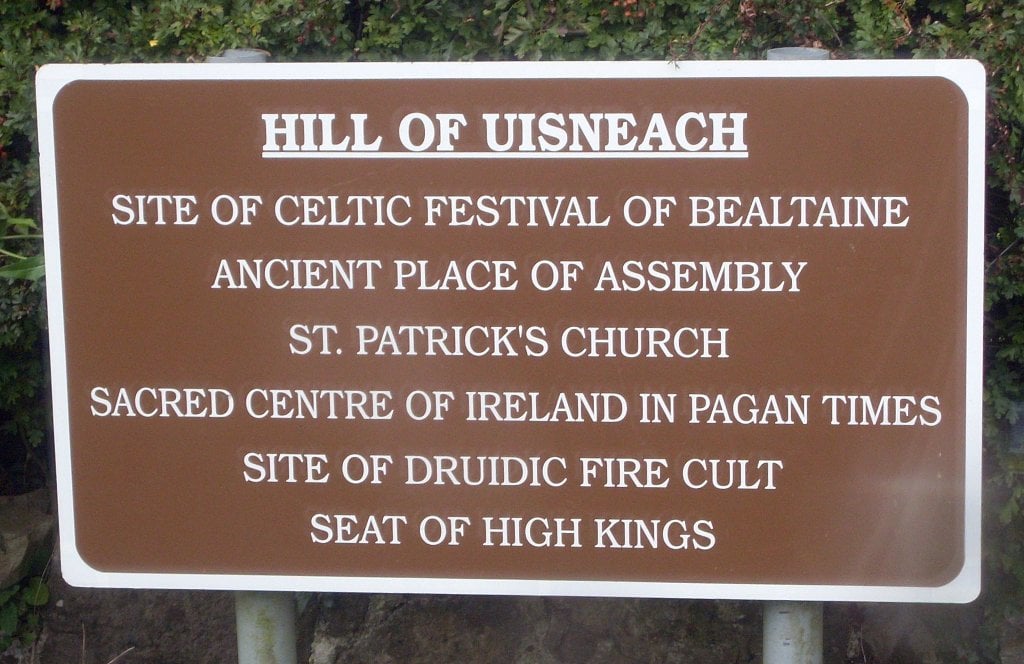
Irish stories and Irish storytelling has been the bedrock of Irish culture since the dawn of time. Irish folklore has travelled with the Irish as they emigrated across the globe taking with them the tales, songs, legends and myths of Ireland along with their hopes and dreams.
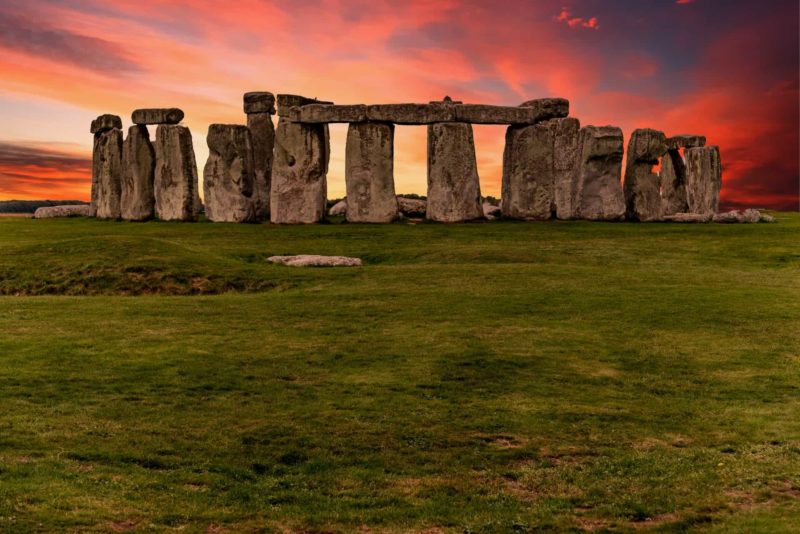
Celtic legends were passed between towns and villages and through generations via the bards and seanchaí the traditional Gaelic storytellers and historians. In those ancient times, stories were not written down and long poems and songs contained the wisdom of Irish folklore and the tales of Irish heroes. Folks travelling to Ireland often want to visit the places of legends, Irish fairies and stories of ancient times.
Irish Mythology
Irish mythology dates back thousands of years to when the Celts arrived in Ireland. Unlike other cultures whose myths detail how their world came into being Irish myths are about how the people of Ireland arrived from somewhere else.
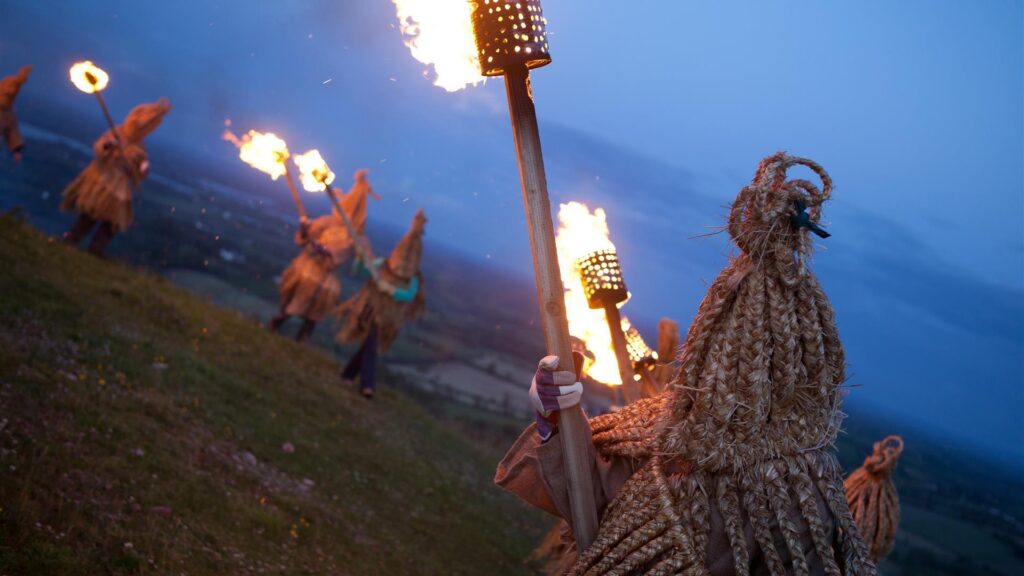
The Cycles of Irish Mythology
Irish mythology falls into 4 different cycles. Each of the cycles is unique to their time and are filled with different stories. This was done by researchers in an attempt to understand the chaotic stories of Irish folklore. The four Irish myth cycles are Mythological, Ulster, Fenian, Historical/Kings.
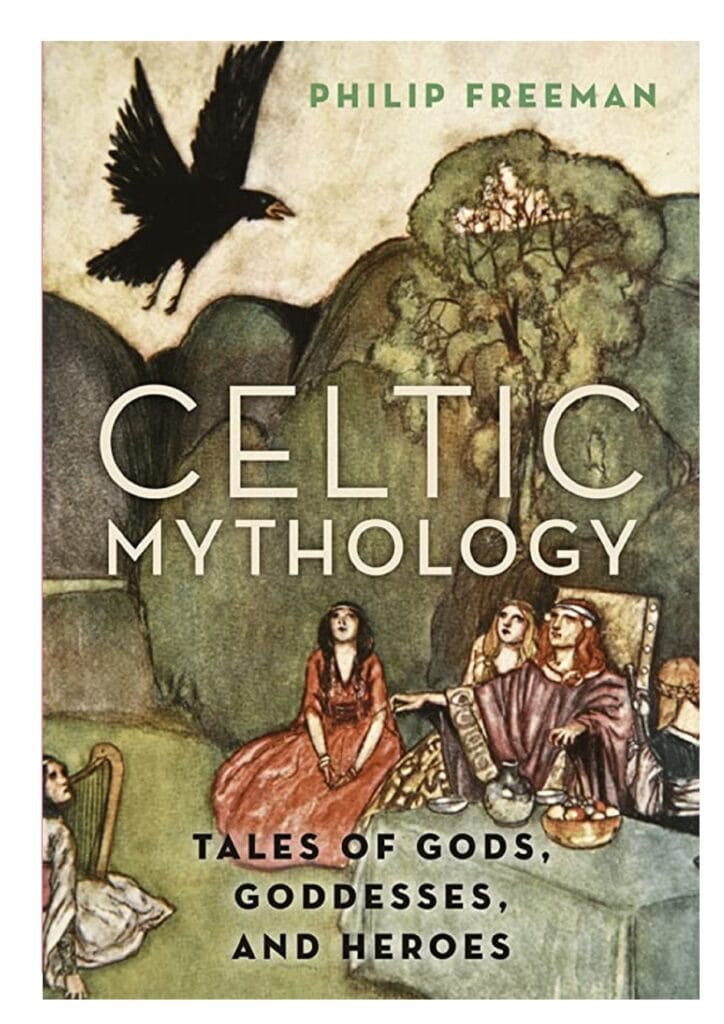
The Mythological Cycle
The earliest group of the Irish folklore cycle is the Mythological Cycle and although it tells of the arrival of humans in Ireland and the 5 invasions it dominantly revolves around the goddesses and gods of the Tuatha Dé Danann.
The Fir Bolgs
The Fir Bolgs were descended from the Nemedians (originally from Greece) and lived in Greece and when they escaped slavery they stole boats and landed in Ireland, free men and women.
It was in Uisneach, that became the sacred centre of Ireland that the Fir Bolgs divided the country into five provinces. The Fir Bolgs possessed Ireland for thirty-seven years before being defeated by the Tuatha De Danann at the first Battle of Moytura.
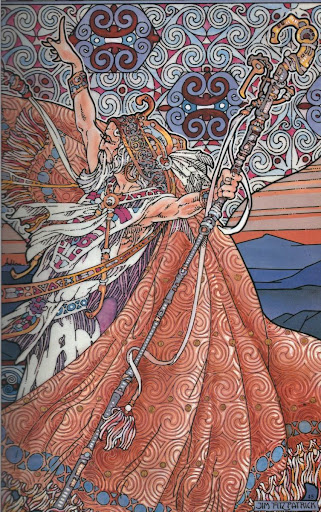
As the legends recounted in the Lebor Gabála (Book of Invasions) the Fir Bolgs built Dun Aengus after they sought refuge on the island. They named the fort after their chieftain, Aenghus, King of the Clann Umoir.
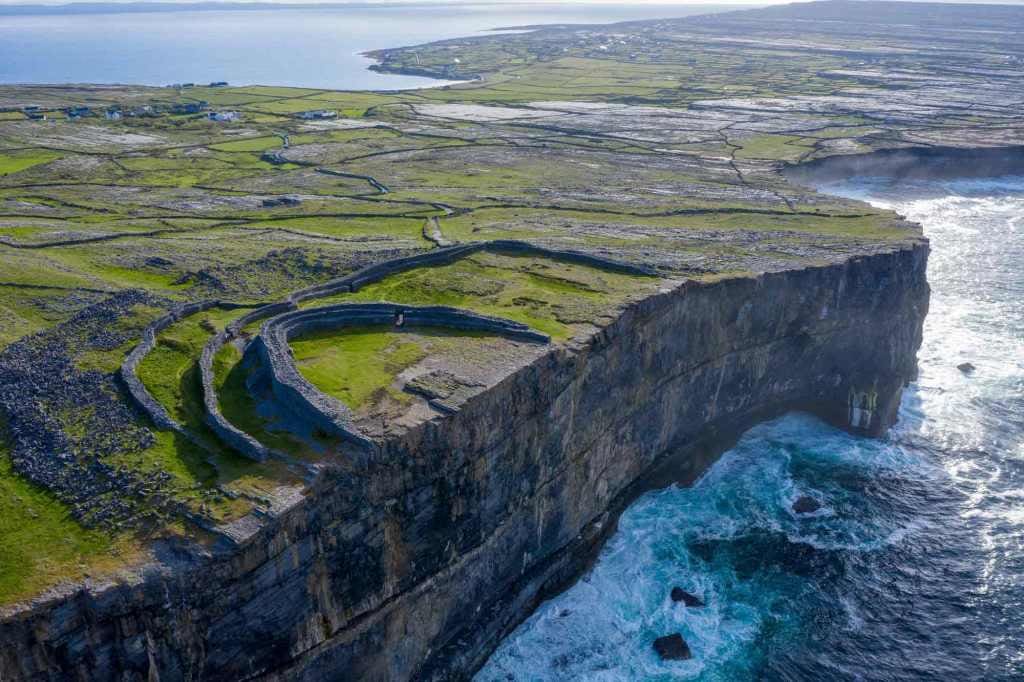
Who were the Tuatha de Danann?
The Tuatha Dé Danann, were the people of the Goddess Danu who when they won the Battle of Moytura established Ireland as a Goddess culture.
Battle of Moytura
Moytura is just east of the village of Cong is an unusual complex of stone circles and cairns. The plain is bounded on the west and south by Lough Corrib to Cnoch Meadh the fairy hill near Tuam. It is called the Plain of the Battalions.
According to Irish mythology, this area of stone cairns in County Mayo was the site of a great battle, three thousand years ago. The battle took place between the Fir Bolgs and the Tuatha De Danann. The story tells us that the Tuatha De Danann, the people of goddess Danu, arrived in Ireland, demanded half of Ireland from the ruling Fir Bolgs. The Fir Bolgs refused and a fierce battle ensued, lasting four days.
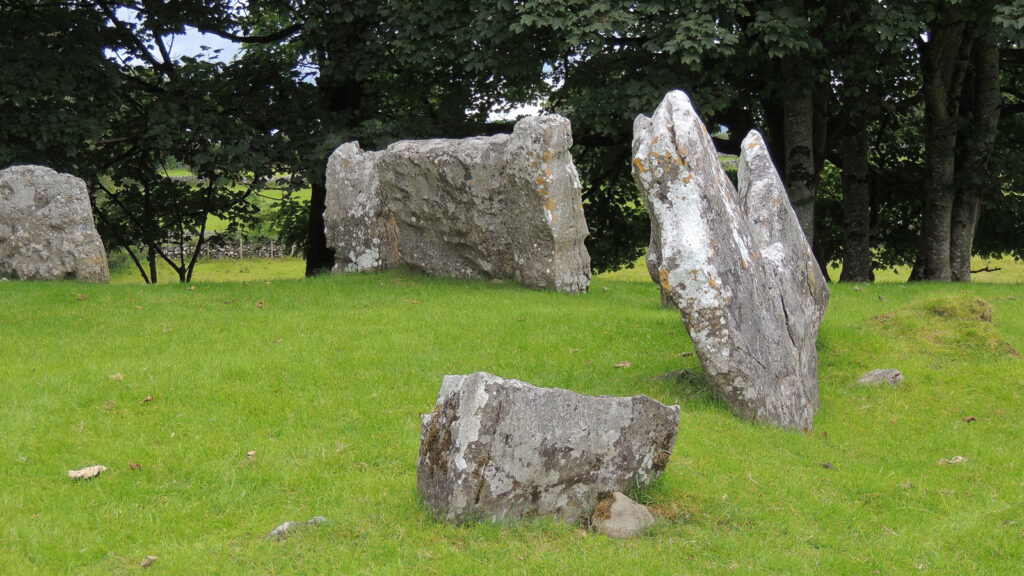
Much of the cycle relates to the exploits of the Tuatha Dé Danann – the people of the goddess Danu. Some of the best-known stories include the Children of Lir, the Wooing of Etain and the Dream of Aengus.
It is unknown when the Tuatha arrived in Ireland and how they came to live there. If they did exist they probably arrived via boat although some beliefs say they arrived on clouds and others state they came from Denmark.
Irish folklore says that the Tuatha came originally from a place called Achaia and then moved onto Denmark. From Denmark, the legends say they moved to Scotland before coming to Ireland.
The de Danaan overcame the Firbolg to take over Ireland and then fought the Milesians. The Milesians were defeated and the Tuatha banished them from Ireland. They were told if they could find and land in Ireland again the country would be theirs.
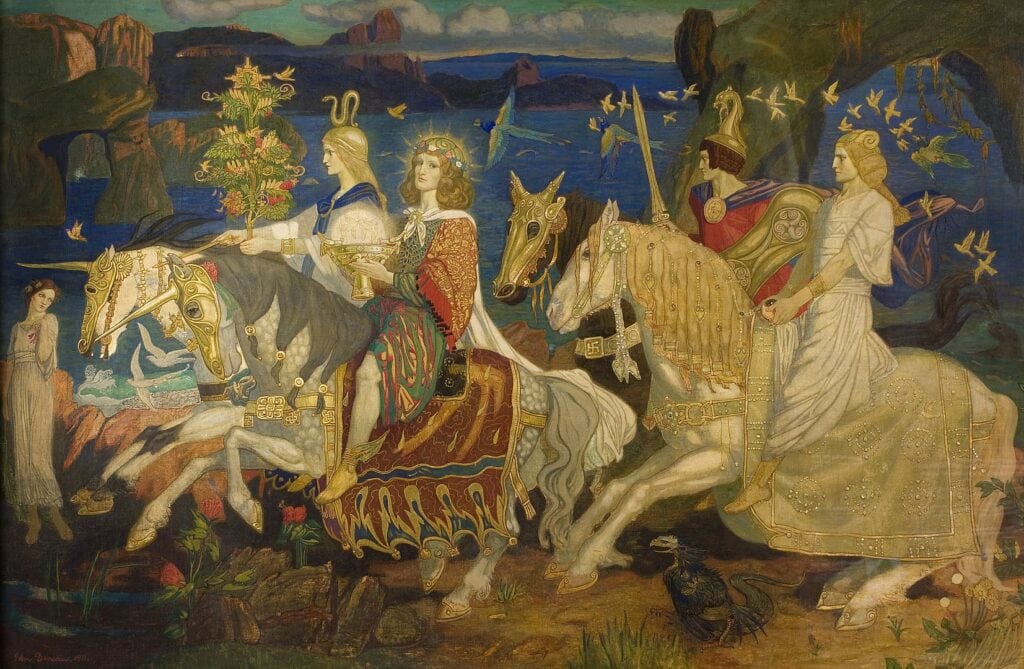
So the Milesians left by boat and the Tuatha raised great storms to ensure they wouldn’t be able to find Ireland again and place spells on the country to make it invisible.
However, the Milesians did make it back to Ireland and eventually, the Tuatha retreated to their underground palaces and cities.
Looking for a great book on the Tuatha – look for GODS AND FIGHTING MEN. The Story of the Tuatha de Danaan and of the Fianna of Ireland was Arranged and put into English.
Ceasair – the first goddess of Ireland
Irish folklore begins with the arrival of Ceasair who was one of the first goddesses of Ireland. Ceasair was a granddaughter of Noah who was not allowed into the ark and so created her own. She built 3 ships and gathered many women to join her to escape the flood. When her father and Fintan (the shapeshifter) were also denied entry to the ark she promised to take them with her as long as they honoured her as the leader.
Ceasair set sail for the Land of Destiny – Inis Fáil believing that since it was yet unpopulated with man-god would not destroy it in the flood as there was no evil to cleanse from the land.
Ceasair’s group was followed by a giant of a man called Parthalon who brought with him his wife and three sons and all their families and retainers. Parthalon was cursed for the sin of murder and he essentially had to leave Greece to outrun the curse.
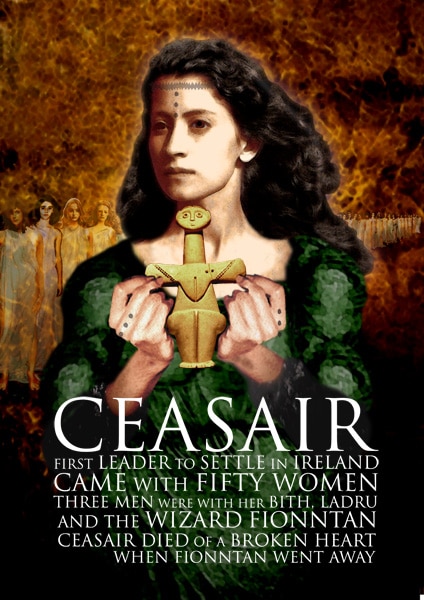
Parthalon’s people explored Ireland and in Donegal, they ran across the powerful sea pirates the Fomorians who were very magically powerful. The two races could not live in peace and so decided to engage in a magical war by accessing the Otherworld and in this battle, Partholon’s people won. A sign of the land accepting their win was that 4 great lakes sprang up across Ireland. Shortly after this Fintan arrived to become their advisor and teach them how to survive in Ireland.
A plague wiped out Partholon and his people and Nemed who was a druid arrived in Ireland 30 years after Partholon’s death. He was a great warrior who defeated the remaining Fomorians and established the beginnings of a great Irish culture.
The Children of Lir
King Lir was the ruler of the Irish sea and felt that he should have been named King of the Tuatha Dé Danann but Bodb Derg was elected king. In order to keep King Lir happy Bodb Derg sent his daughter Aoibh to marry Lir and with whom he had 4 children.
When she died bodb Derg sent his second daughter Aoife for the King to marry. Aoife quickly became jealous of the time the King spent with his children.
Aoife decided to ensure she was the King’s only focus she would cast a spell that would transform the children into swans for 900 years to wait for their freedom.
Fionnghuala Lir’s daughter said to Aoife that her magic was not as great as she believed and warned her of the revenge that would be taken on her. She asked that the spell have a time limit. Aoife set a limit of 900 years – three hundred years as a swan on Loch Dairbhreach, three hundred more on Sruth na Maoilé, and three hundred at Iorrus Domnann and Inis Gluairé.
Aoife did allow the children to retain the power of speech and said they could sing as much as they pleased. Aoife then returned to Bodb’s court where her father asked for the children. Bodb sent a message to Lir who realized that Aoife had done something to the children.
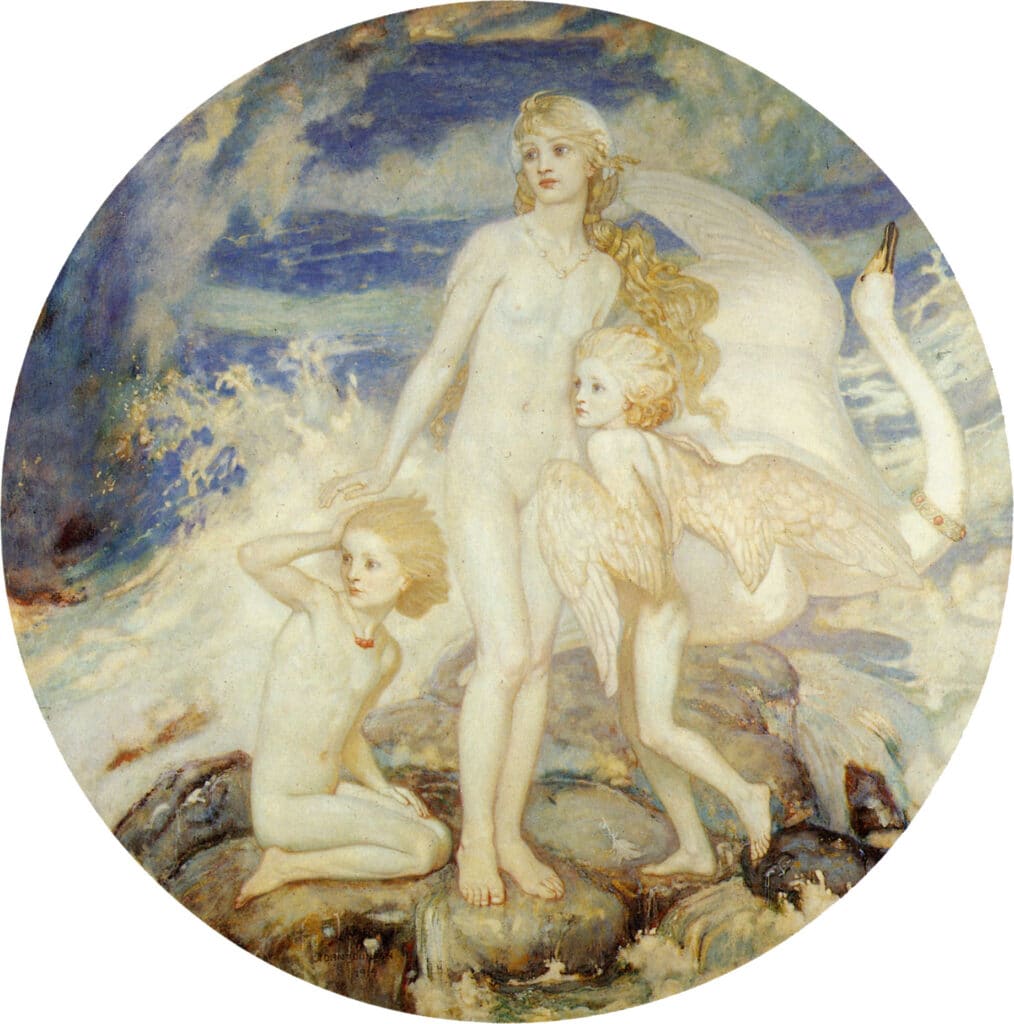
Lir set out to find the children and on the shore of Loch Dairbhreach, he heard swans singing with human voices. They told him of Aoife’s evil act, and Lir went to Bodb and told him the story. Bodb cursed Aoife and changed her by a strike of his Druid’s wand into a demon.
Over the 900 years, Ireland moved from a pagan country to a Christian one and this is where Christianity turned the story of the Children of Lir into a Christian tale.
One day the monk Mochaomhóg arrived at Inis Gluairé — the swans heard him ringing a bell calling matins, Fionnghuala declared the sound of the bell would liberate them from the curse of the spell, and so they listened to it. When it finished they sang a song. The holy man heard their song and discovered that it was swans that sang it.
Lairgnen, the King of Connacht attempted to obtain the swans for his wife but the monk refused. Lairgnen was angry and attempted to take the swans but when he touched them the feathers fell off them revealing three very old men, and an old woman. Fionnghuala asked the monk to baptise them and to bury each, stating she sensed they were close to death. They were baptised, then died, and were buried as Christians.
The Wooing of Etain
This wooing is another romance of Irish Mythology, humans have taken over Ireland and the Tuatha Dé Danann have gone underground after their defeat by the Milesians and become the Aes Sídhe, the “people of the fairy mounds”.
Midir the son of the Dagda of the Tuatha Dé Danann, Lord of Brí Léith of Ardagh Hill in Longford, takes the daughter of Ailill – Étaín, as his second wife, but his first wife Fuamnach does not approve and attempts to separate them – first by turning Étaín into a butterfly and then causing a windstorm to blow her far away.
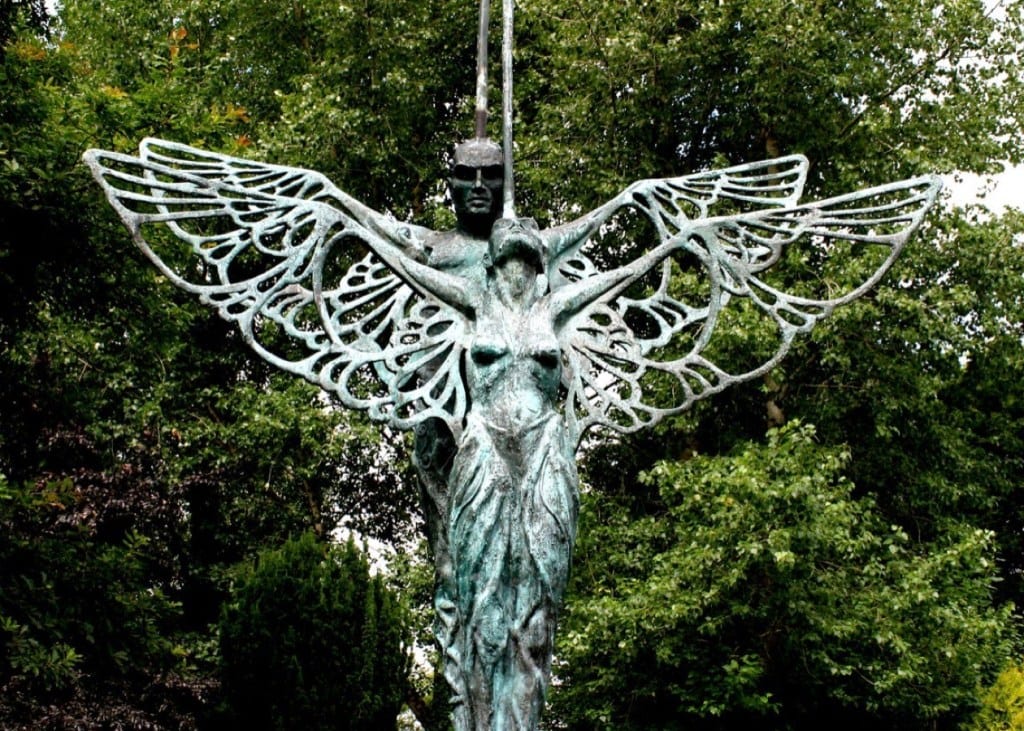
Many dramatic adventures later the butterfly ends up landing on a wine cup of the wife to Etar, a lord of Ulster and is accidentally swallowed. The lady gets pregnant and gives birth to Étaín, the daughter of Etar. As this reincarnated Étaín grows up, she is proclaimed the most beautiful woman in Ireland. The High King of Ireland, Eochaid, asks to marry her and she agrees.
But Midir has never stopped looking for Étaín, and he recognizes his wife as the new queen of Ireland. But Étaín has forgotten her former life among the Aes Sídhe and will not leave her husband which forces Midir to resort to cunning and magic to wrest her from Eochaid.
This story seems to go on forever and you can read more about the complexities of this Irish myth here.
Dream of Aengus
Aengus was the son of the gods, the Dagda and Boann. Boann was the wife of Nechtan at the time and had a secret affair that led to the conception of Aengus. To prevent this secret from getting out, the Dagda cast a spell making the sun stand still for nine months. This meant Aengus was effectively conceived and born within one day.
When Aengus grew up and returned home he discovered that The Dagda (his true father) has shared all the land between his 4 brothers who are legitimate leaving nothing for him. Aengus is furious and plays a trick to take away the Dagda’s home of Brú na Bóinn (Newgrange), which is now famous for its passage tombs.
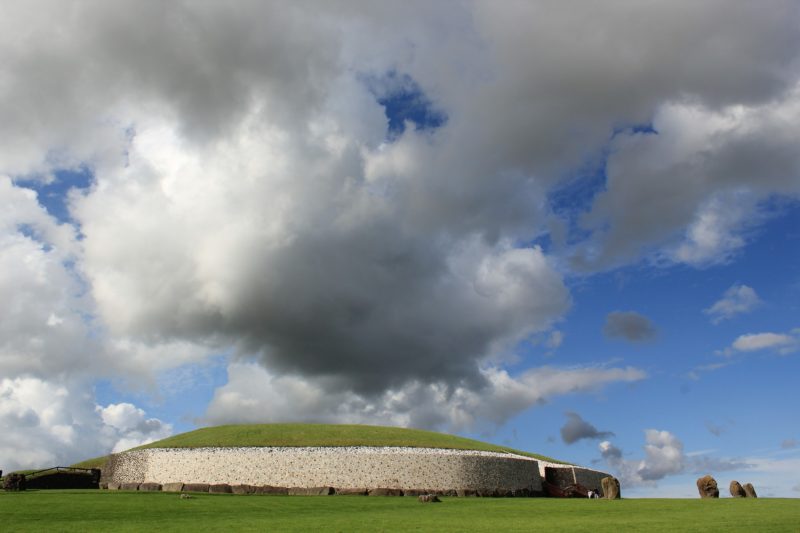
The Ulster Cycle
Folklorists say the Ulster Cycle took place around the first century and this particular cycle introduces the warriors and battles of Irish folklore.
The Birth of Cu Chulainn
Deichtre was the mother of Cuchulainn and the sister of the King of Ulster Concobhar Mac Nessa and she was a brave and adventurous woman. One day she gathered 50 of her maidens together and left Ulster for new adventures. Deichtre and her ladies found a new home for themselves in the Land of the Tuatha (the fairies). One day in her new home she happened to swallow a tiny Mayfly that landed on her glass. That night she dreamed that a handsome man (who turned out to be the God Lugh) came to her and said that she would bear his son who was to be called Setanta.
Her brother and his men searched for her for 3 years and finally tracked them all to the stronghold where they were welcomed by a Fairy who invited them in. As was the custom Concobhar requested that his host’s woman was sent to him to sleep with.
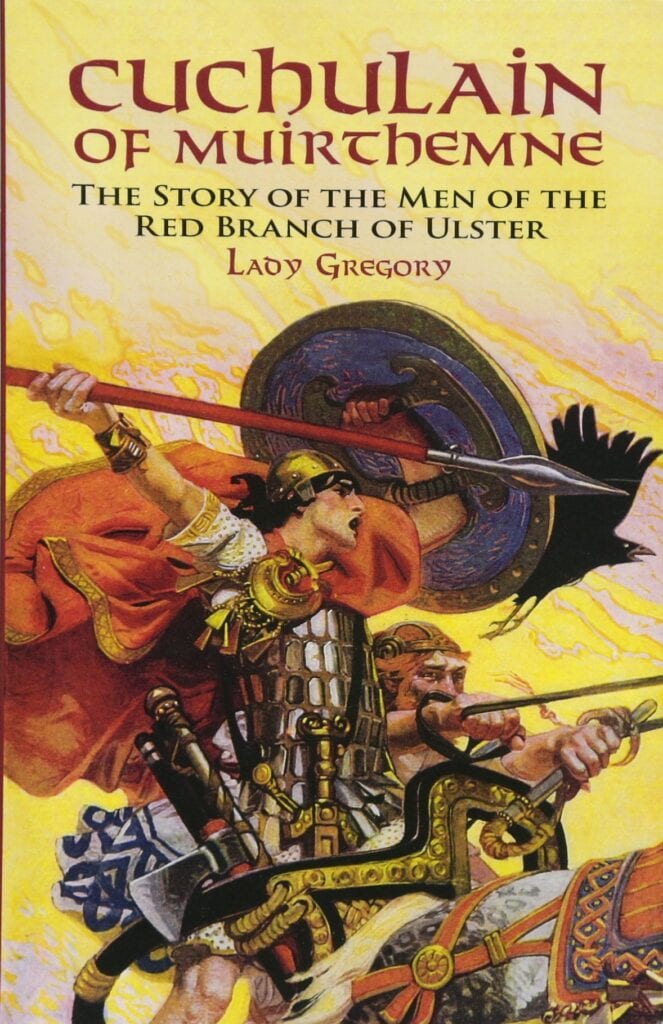
This was initially refused as the woman (Deichtre) was in labour. When Concobhar went to sleep and woke the next day he found a baby in the folds of his cloak. Deichtre confessed that it was her son and she left with Concobhar and returned to Ulster. The boy grew up and was educated and trained and later became known as Cuchulainn.
The Fenian Cycle
The Fenian Cycle of Irish mythology tends to focus on the great warriors of the time. These included the Irish stories of Fionn Mac Cumhaill and Cuchulainn.
Finn MacCool and the Salmon of Knowledge
Fineagas was Fionn’s tutor and he had lived alone seeking the elusive Salmon of Knowledge. Irish legends said that the first person who could catch and taste the salmon would have the power to look backwards and forwards in time and gain all knowledge of the world.
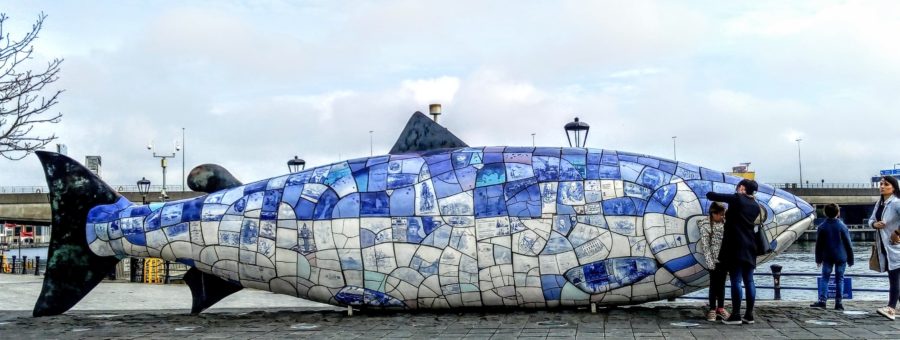
Fionn was sitting by the river with Fineagas learning Latin and he noticed that the water was disturbed – it was the Salmon of Knowledge. Fineagas tried to catch the fish and spent hours of wrestling with the Salmon. Once he finally landed the fish he asked Finn to cook it while he had a nap.
Fineagas ordered Finn not to eat any of the fish until he awoke as the first person to taste it would gain the knowledge. The cooked fish sputtered and spat on the fire and inadvertently splashed Finn who licked the fingers that were splashed.
When Fineagas woke up he knew right away that Finn had tasted the fish but he wasn’t angry with him as he knew that the boy would become great and knowledgeable from the taste of the Salmon.
Legend of the Giant’s Causeway
At the dawn of time in Ireland there lived a giant named Finn mac cumail (Finn McCool) he was a massive 54 feet tall and said to have the strength of 500 men. He was married to Oonagh and lived happily on the Antrim Coast.
Across the waters in Scotland lived a giant known as Benandonner who believed he was the strongest giant in the world. Benandonner would harass and taunt Finn across the waters and one day he just pissed Finn off so much that Finn picked up a lump of earth and threw it at him. The lump missed and fell into the Irish Sea creating what came to be known as the Isle of Man and the hole left by the earth lump became Lough Neagh.
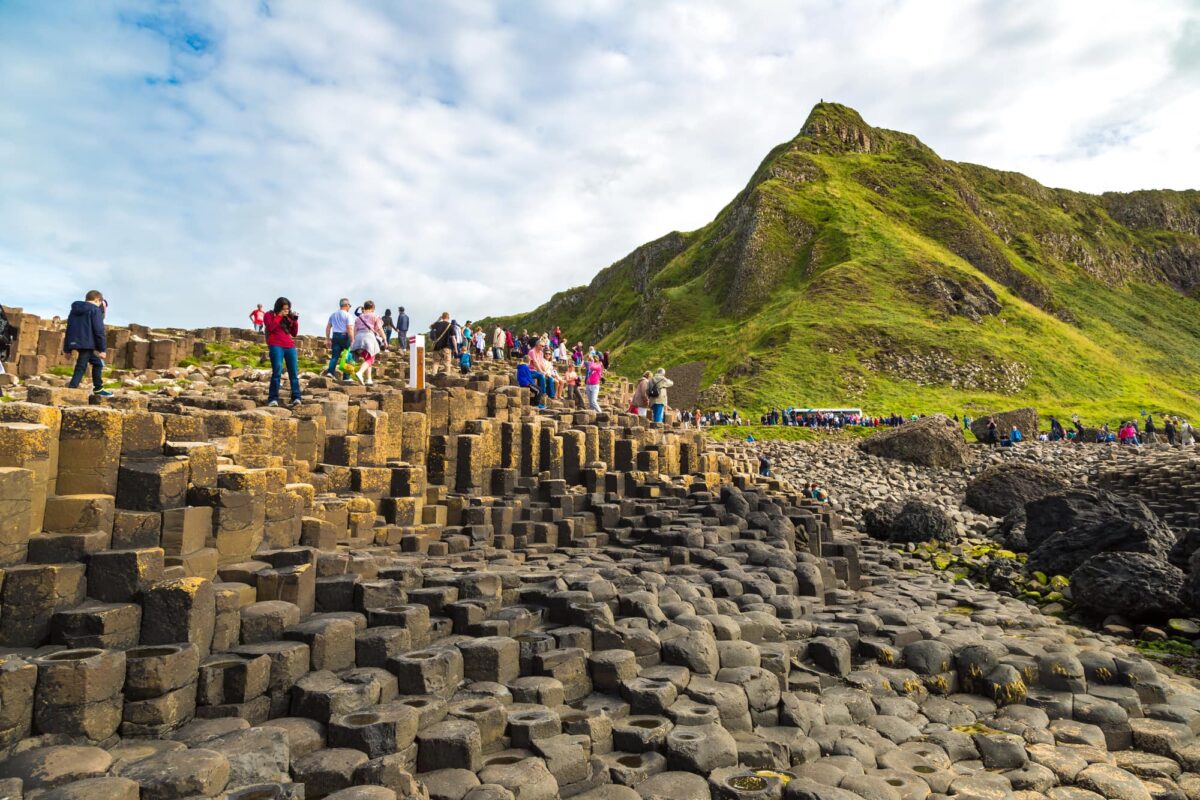
Finn got sick and tired of all the harassment and decided to build a path to Scotland so he could fight Benandonner once and for all. The Giant’s Causeway Finn laid down was joined by the path that Benandonner built from Scotland. For weeks the giants toiled building a path to each other.
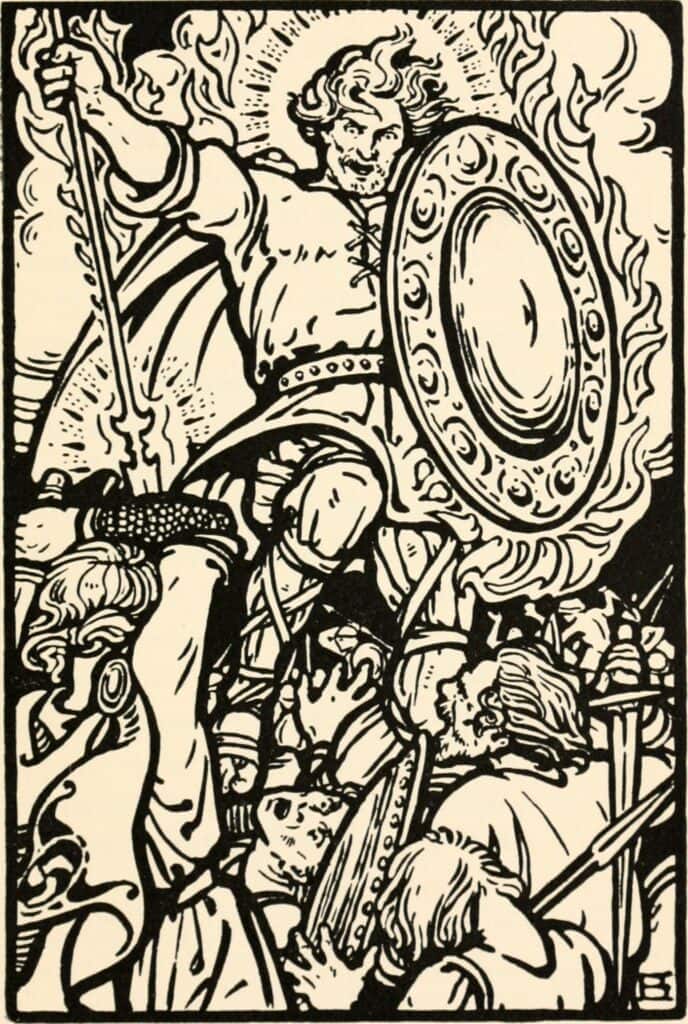
Finally, the two paths met and Finn saw Benandonner coming over the hill and was shocked by the huge size of the Scottish giant. Since Benandonner had not yet seen Finn he ran back to his house and asked Oonagh to help him hide. Being a very smart woman she disguised Finn as a baby and put him into a huge cradle. When Benandonner knocked on the door Finn pretended to cry. Benandonner spotted the ‘baby’ and thought to himself if the baby was that gigantic how big was Finn himself. So Benandonner turned and ran back to Scotland destroying the causeway behind him so Finn couldn’t follow him.
The Cattle Raid of Cooley
The Tain Bo Cuailnge in English known as the Cattle Raid of Cooley is one of the best-known stories that involve the warrior Cu Chulainn.
Queen Medb of Connaught wanted a prize bull and so she gathered an army to steal the bull which was owned by Daire, a chieftain of Ulster.
This Irish epiclike tale deals with the conflict between Ulster and Connaught over the possession of the brown bull of Cooley. The tale was told in a poem in the 7th and 8th centuries. It is partially preserved in The Book of the Dun Cow and is also found in The Yellow Book of Lecan (late 14th century).
Although Queen Medb is warned of doom if she proceeds, by a prophetess, the Connaught army heads to Ulster. The Ulster warriors are temporarily disabled by a curse, but Cú Chulainn, is exempt from the curse and single-handedly holds off the Connaughtmen.
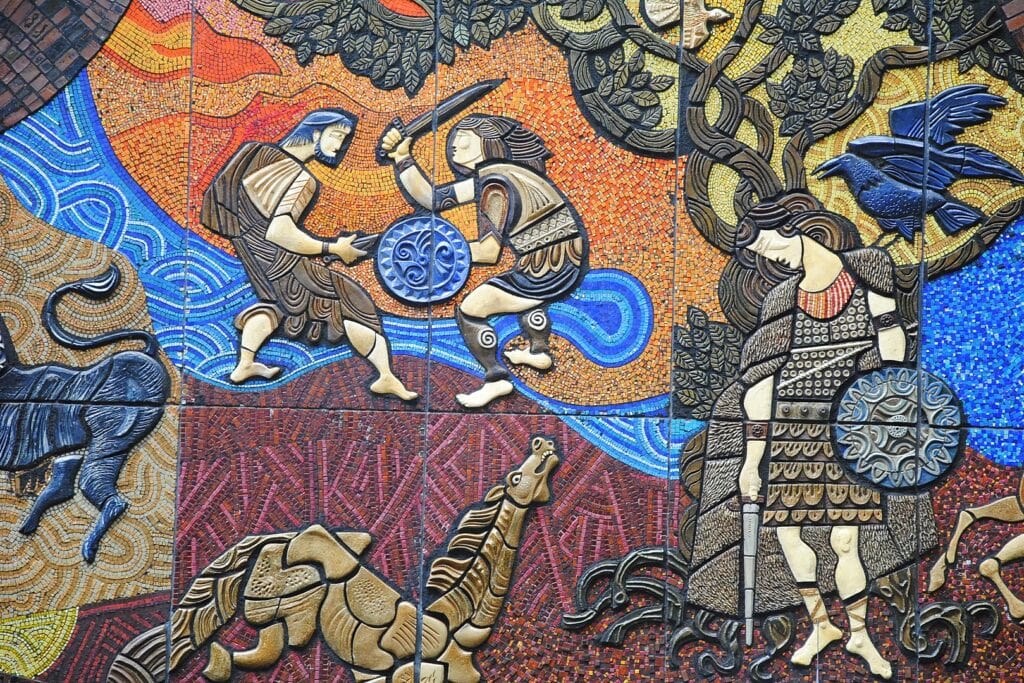
The fight lasts three days with combat between Cú Chulainn and Fer Díad, his friend and foster brother. Cú Chulainn is victorious, and, nearly dead from wounds and exhaustion, he is joined by the Ulster army, which routs the enemy. The brown bull, however, has been captured by Connaught and defeats Ailill’s white-horned bull, after which peace is made.
The Morrigan
The Morrigan is the Celtic Goddess of war a shape-shifting goddess who used her powers to predict and cause the death of warriors.
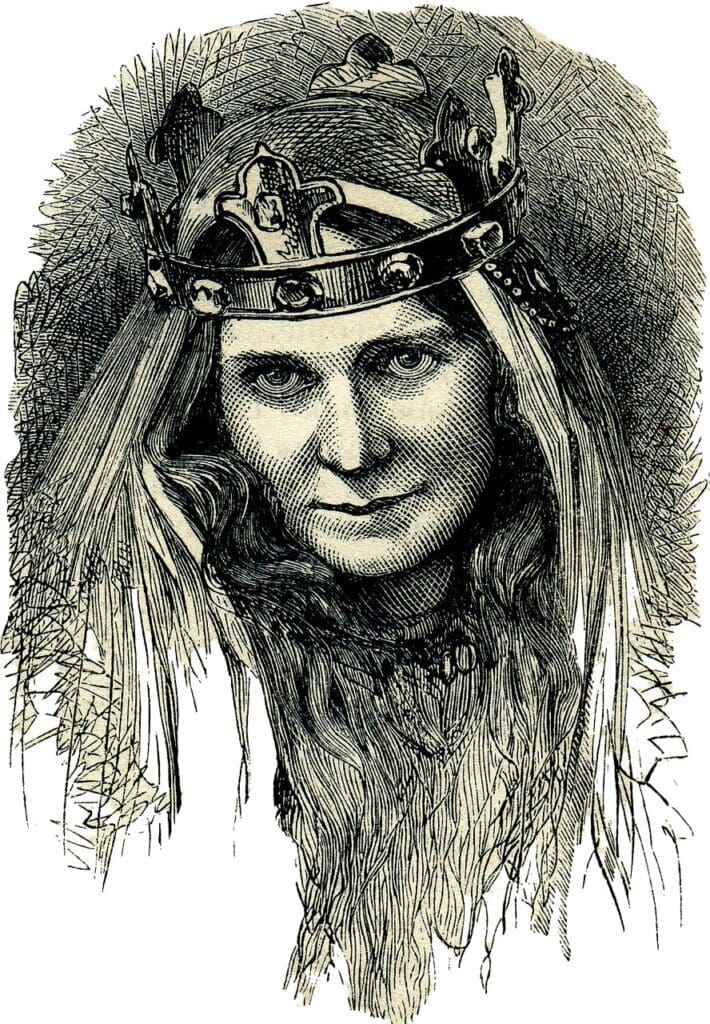
The Death of Cu Chulainn
This ancient Irish folktale tells of how the Morrigan met Chu Chulainn while he was defending Ulster from Queen Maeve during the Cattle Raid of Cooley.
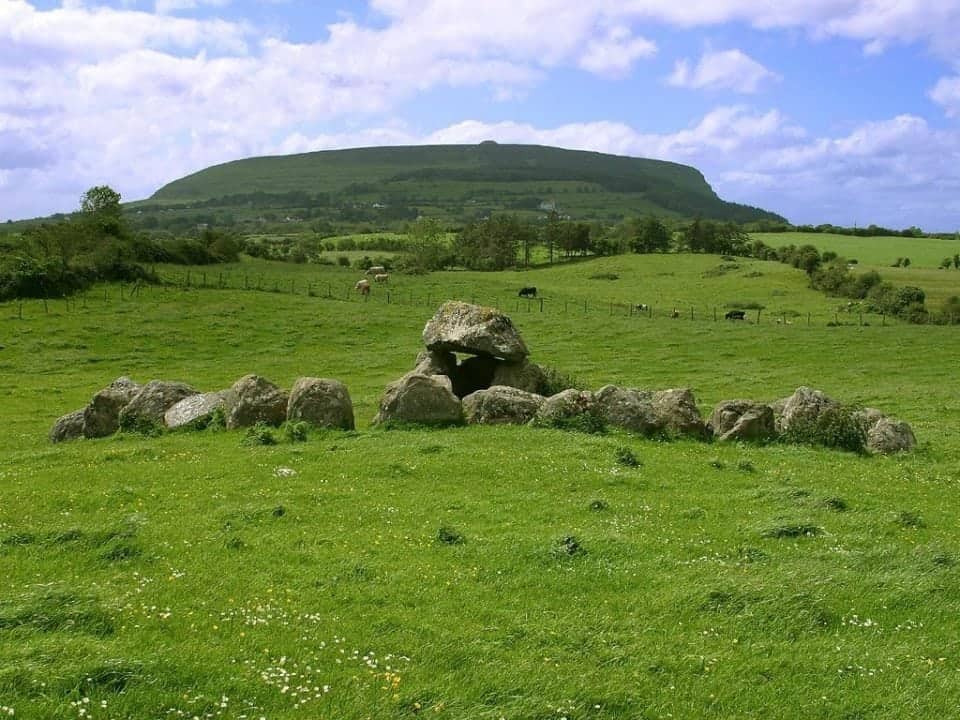
The Morrigan – so the story goes – fell in head over heels in love with the stunningly handsome Cu Chulainn and tried to seduce him before he entered the battle, but he declined her advances. The goddess was naturally a tad pissed off.
Cu Chulainn’s death came about when he broke two ancient curses. He had been placed under a geasa which is the imposition of injunctions or prohibitions commonly known as taboos. Cu Chulainn’s Geasa were to not refuse someone’s hospitality and he was forbidden to eat dog meat.
One day, while out hunting, Cu Chulainn was approached by three old hags (the Morrigan disguised as the 3) who offered him dog meat and the hospitality of the fire used to cook the meat.
His honour as a warrior would not allow him to turn down the hospitality, and when the meat touched his lips, all the strength in his left arm left his body and the meat fell onto his leg and the strength of his leg leaked away. He knew that he had broken the geasa and lost half his strength. This was his punishment from the Morrigan for refusing her love
He was defeated in his next battle with the sons of Catalan and was left dying standing upright on his feet as a true warrior.
The Cycles of the Kings/ Historical Cycle of Irish Myths
The historical Cycle of Irish myths tends to date to after Saint Patrick’s arrival in Ireland and is influenced by Christianity.
The Irish legends and tales in this cycle centre around the Kings of Ireland and the stories moved from pagan supernatural tales to more actual historical stories.
The Pursuit of Diarmuid and Grainne
Grainne’s cave is one of the highest in Ireland but it is on private property in the cliffs of Annacuna, which are at the back of the Gleniff Horseshoe in Sligo and it is a very dangerous climb.
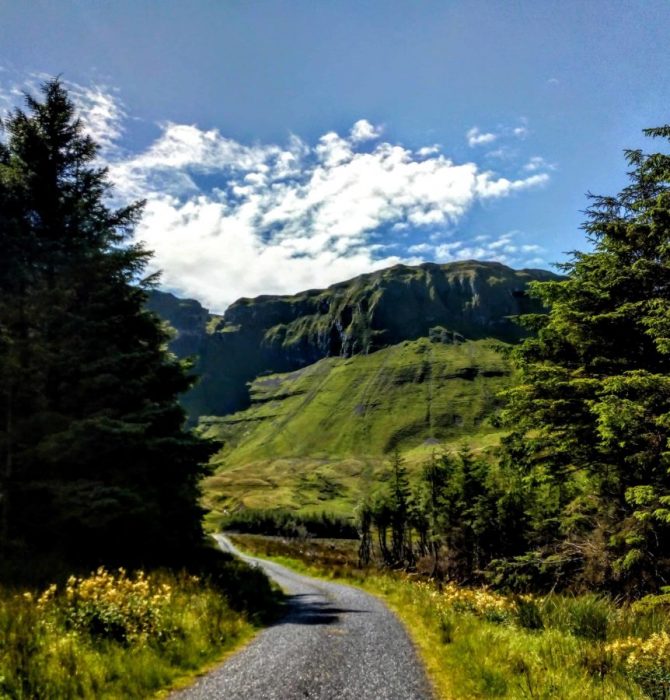
If you are going to try to climb it, make sure you get the owner’s permission. (There is also a Grainne and Diarmuid related Sea Stack on the Loophead Trail.)
The legend goes that Grainne was to marry a great warrior and king called Fionn McCool but instead fell in love with one of his handsome warriors Diarmuid and placed a spell on him.
The legend is similar to that of Lancelot and Guinevere. For many years after fleeing together Grainne and Diarmuid lived in a variety of caves and hidden places in the mountains. One day a heavily pregnant Grainne was confronted by a wild boar – the only animal it was said could kill Diarmuid.
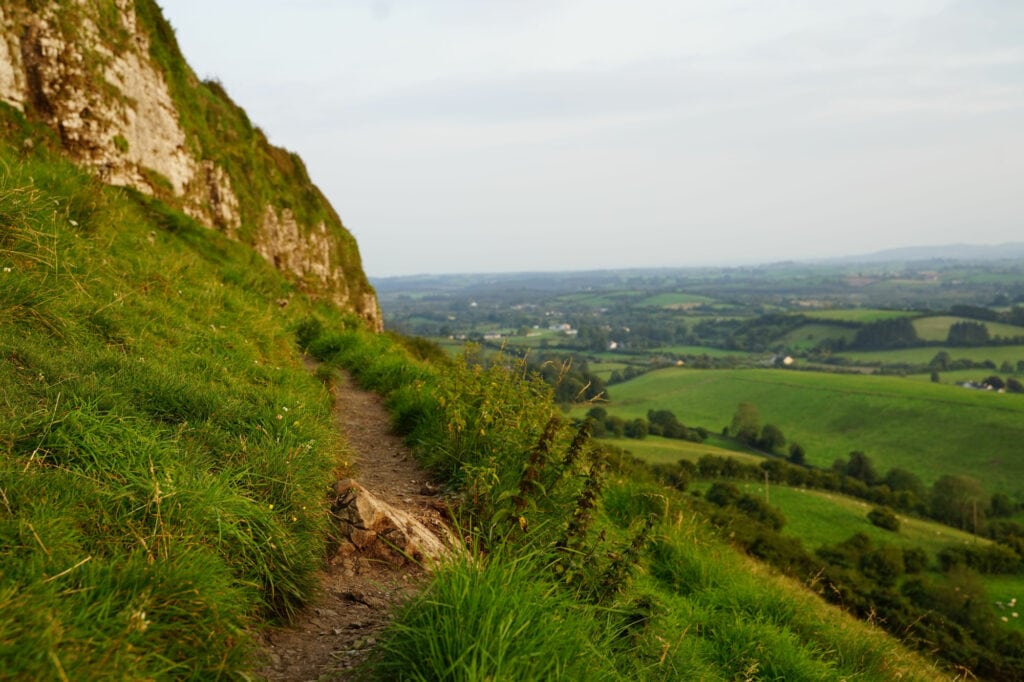
Fighting off the board to save Grainne, Diarmuid was gored and lay dying in Grainne’s arms when Finn and his men came upon them. Grainne begged Finn to get some water which cupped in his hands apparently became magical.
Finn refused and was eventually challenged by his son Oisin to a duel to save Diamond’s life. By the time, Finn agreed it was too late and Diarmuid had died.
Niall of the Nine Hostages
Historians seem to believe that there was a person who lived in roughly the same time period as Niall but that many of the stories and legends surrounding this ancient Irish King have been exaggerated over the years.
Irish myth has it that he was descended from the first high king of Ireland Conn of the Hundred Battles, who may have lived in the middle of the 2nd century. There are no records but it is thought that he fought his way to become King of Tara in the late 4th or early 5th century.
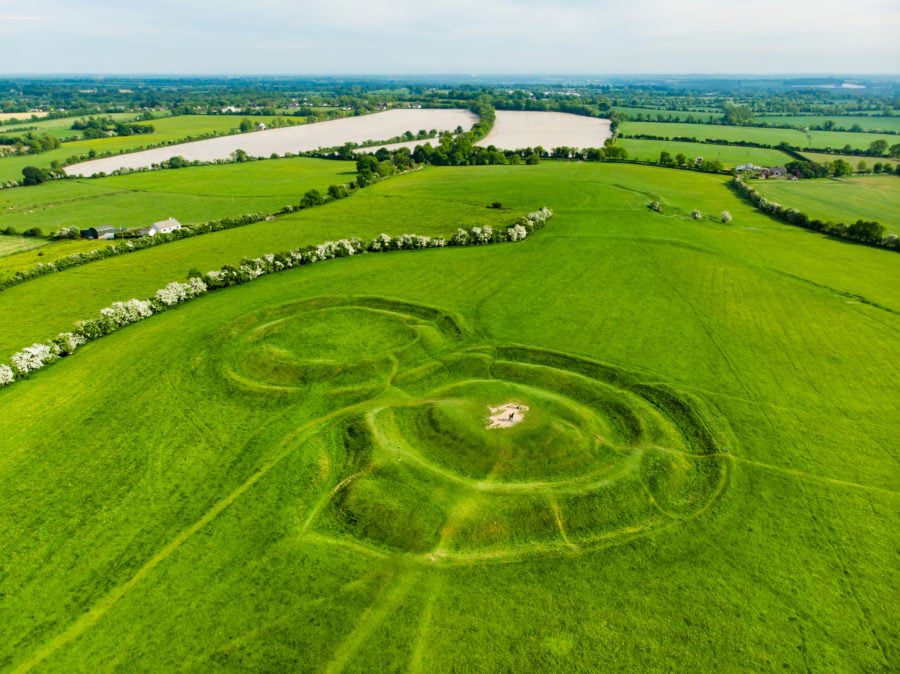
Ruling from Tara, Niall decided that in order to bring peace to Ireland and strengthen his ability to rule that he would take hostages from the provinces. This included the 5 provinces of Ireland (Connaught, Munster, Leinster, Ulster and Meath) and the other four were a Gaul, a Saxon, a Briton and a Scot.
Great Irish myths and legends
Tír na nÓg
Tír na nÓg is the land of eternal youth, a paradise that is inhabited by the Tuatha in Irish mythology. The most popular legend about this mythical land is that of Oisin and Niamh.
One day when Oisin was out hunting out of nowhere a beautiful woman on a white horse appeared and told Oisin that she wanted to take him to Tír na nÓg.
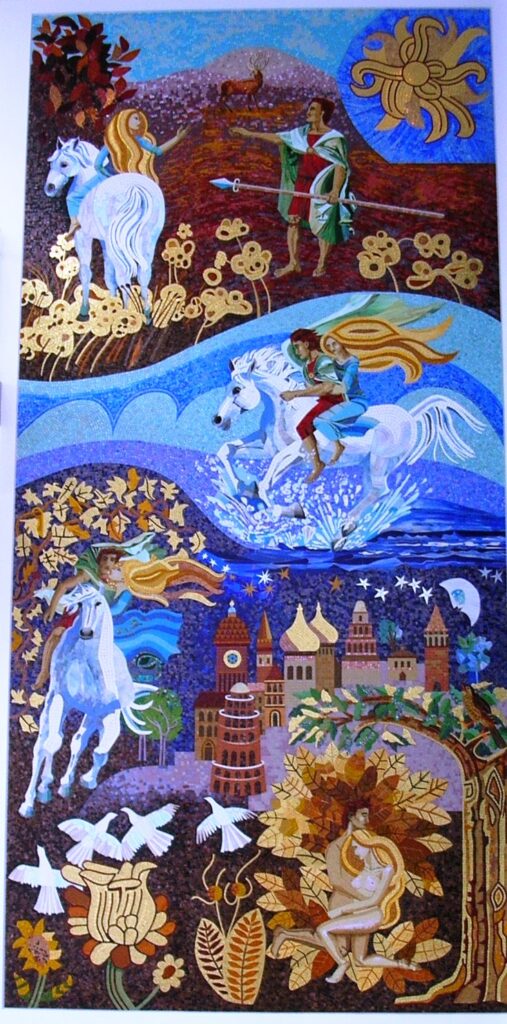
Oisin had fallen in love with this beautiful woman and he agreed to travel with her. They spent 3 years in Tír na nÓg but he began to be homesick and it was told that he could visit Ireland as long as his feet never touch Irish soil.
Niamh reluctantly lets him return on her magical horse but when Oisin arrived in Ireland he discovered that 300 years had passed he was so shocked he fell from his horse to the ground. As he touched the ground he instantly aged and died.
Into the West is a lovely Irish film about two young boys, Tito and Ossie, whose father was “King of Irish Travellers” until his wife, Mary, died during childbirth. The boys’ grandfather is an old story-telling Traveller, who regales the children with Irish folk-tales and legends. When he is followed by a beautiful white horse called Tír na nÓg from the sea to Dublin, where the boys and their father have now settled down in a grim tower block.
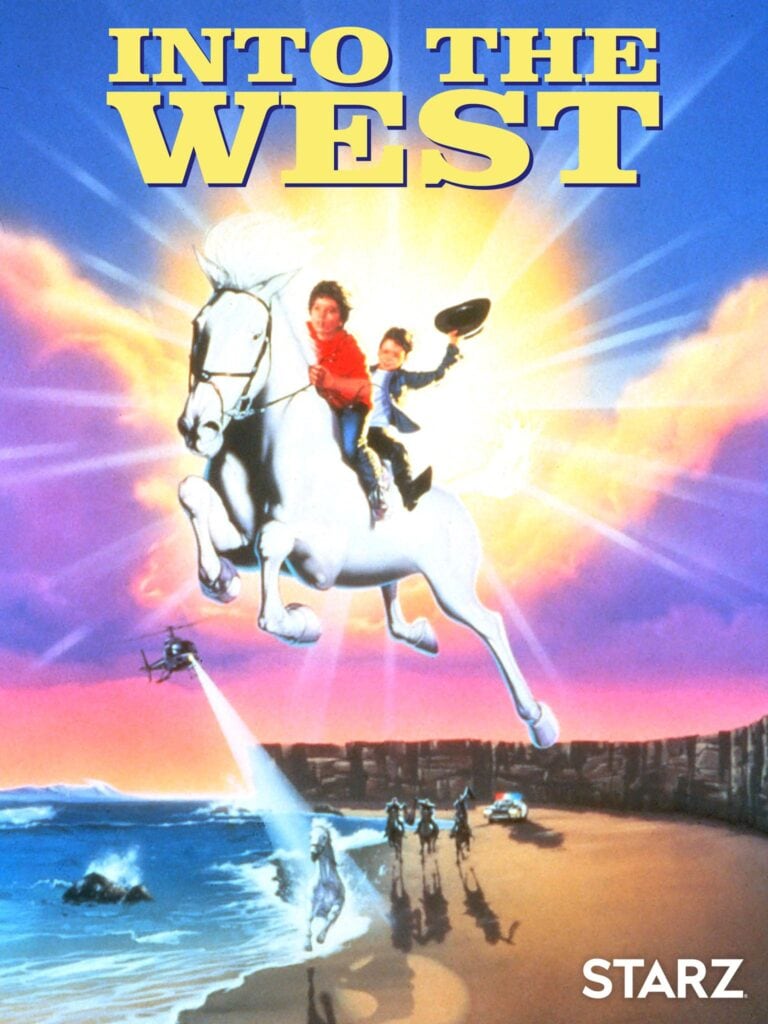
The horse is stolen from them and they begin their adventure to get their mystical horse back. They escape the poverty of Dublin and ride “Into the West” where they find that Tír na nÓg is not just a horse.
The Abhartach
It was Patrick Weston Joyce who first named the Abhartach in his book The Origin and History of Irish Names of Places. The book contains a story about a place in Derry called Slaughtaverty. It was here where, many years ago, an evil dwarf that possessed magical powers lived.
This dwarf was a magician, and a dreadful tyrant, and after having perpetrated great cruelties on the people he was at last vanquished and slain by a neighbouring chieftain; some say by Fionn Mac Cumhail. He was buried in a standing posture, but the very next day he appeared in his old haunts, more cruel and vigorous than ever.
And the chief slew him a second time and buried him as before, but again he escaped from the grave, and spread terror through the whole country. The chief then consulted a druid, and according to his directions, he slew the dwarf a third time, and buried him in the same place, with his head downwards; which subdued his magical power, so that he never again appeared on earth. The laght raised over the dwarf is still there, and you may hear the legend with much detail from the natives of the place, one of whom told it to me.
— Joyce, The Origin and History of Irish Names of Places
The Dearg Due
The legend of the Dearg Due is that of a tragic love story and holds many symbols that eventually became the basis for all our vampire stories. The Dearg Due was a young and beautiful woman who fell in love with the wrong man – a peasant in the village of Waterford.
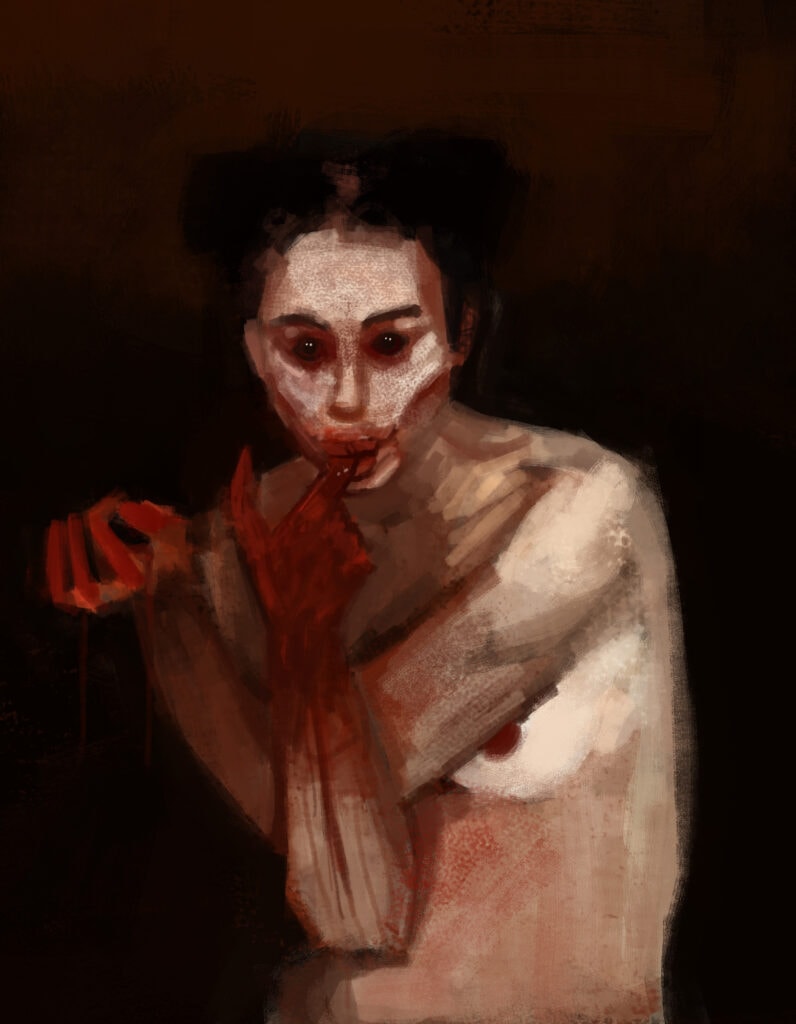
Her father was not about to waste her on a poor man and so arranged her marriage to a rich, cruel tyrant Chieftan from a nearby village.
The Chieftan kept her locked in a tower where he could torture and use her at his will. Eventually, she realized that her love would never be able to save her and she starved herself to death. Her restless spirit was desperate for revenge and after she was buried for one year she dragged herself from her grave to enact her revenge.
She first visited her father in the night and drank his blood and then did the same to the Chieftan who tortured her.
Bean Sídhe
The woman of death or the banshee in Irish folklore is said to wail and shriek when there will be a death in your family. Others believe that each family in Ireland has its own Banshee.
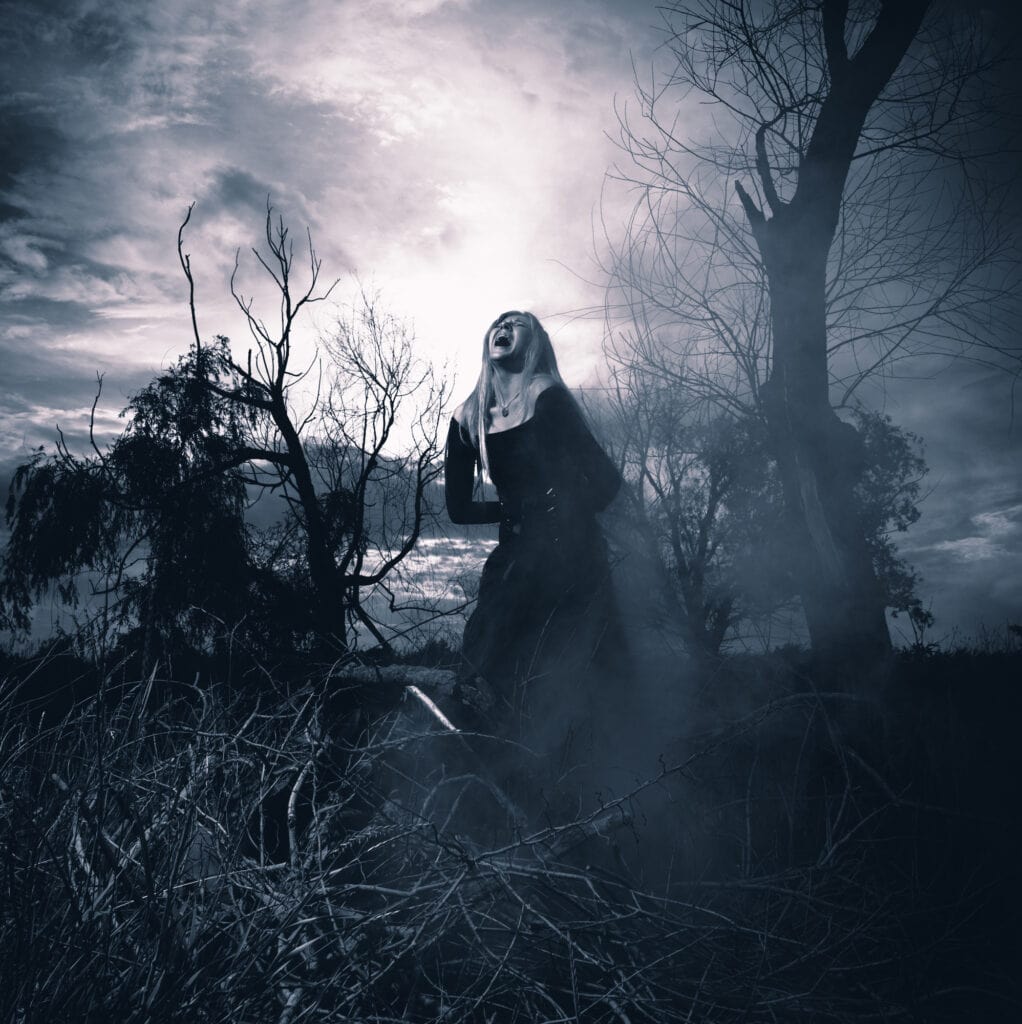
The Puca
The Puca is considered a member of the Faerie family and it is a shapeshifter. Puca’s have the power of speech and tend to exaggerate and lie in order to create mischief wherever it goes.
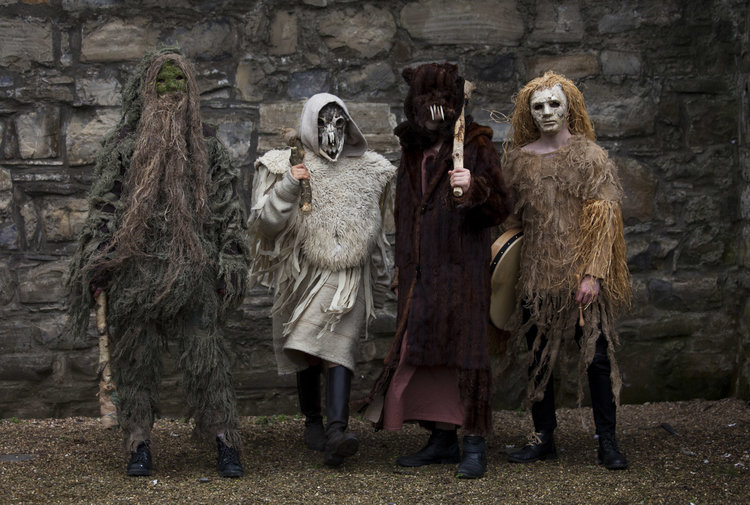
In Ireland, the Púca seems to be the most feared Faerie possibly because it appears only at night and enjoys creating havoc and mischief. But the Puca never seemed to actually hurt anyone. These days you can celebrate the Puca Festival in many parts of Ireland at Samhain.
Leprechauns
Leprechauns are the symbol of Ireland and said to roam Ireland before humans arrived and of course to have a pot of gold buried at the end of the rainbow.
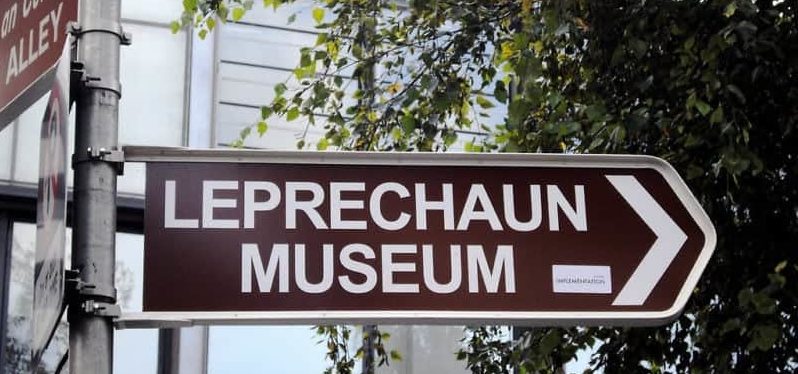
Leprechauns are a friendly type of fairy but it is said that they cannot be trusted.
The Irish harp
The harp is of course the national symbol of Ireland and it is said that evil Fomorians (a race of giants) stole the King of the Tuatha de Danann’s – The Dagda’s – harp that he played for the people.
The harp was called Uaithne and it was made from the sacred oak tree and covered in jewels and only the Dagda could play it. The harp when played by the Dagda made the seasons blossom and the people were filled with joy.

Eventually, the Dagda found his harp and played it so the giants slept and he could return the harp to the land of the fairies.
The Dullahan – the headless horseman
An Irish legend that gave birth to the great American story the Legend of Sleepy Hollow. In Irish mythology, the headless rider on a black horse, carrying his head was said to ride fast through the counties of Sligo and Down. If the horseman stopped it meant someone was going to die.
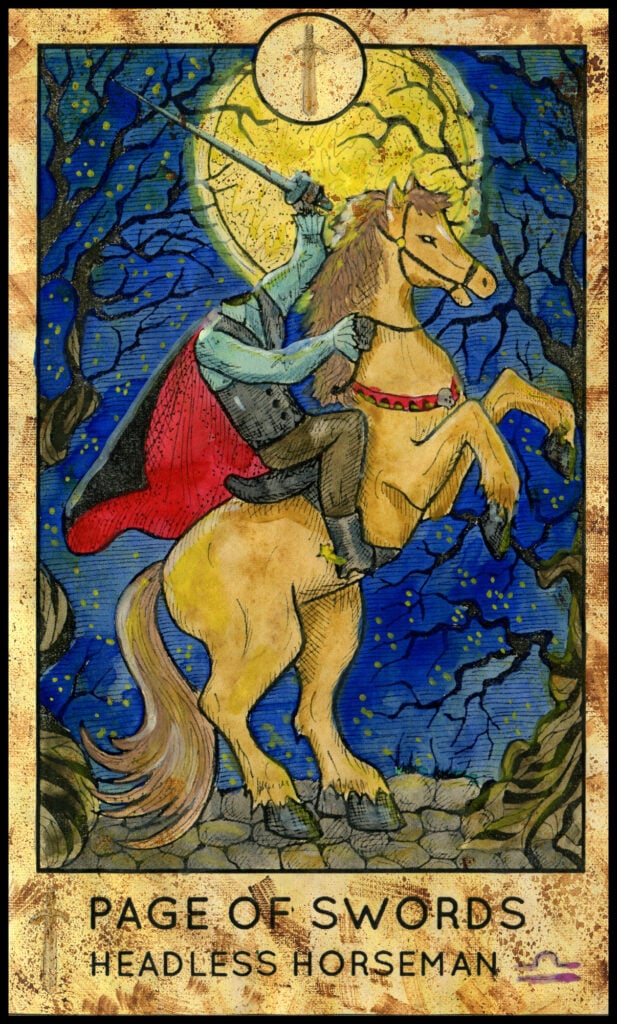
You’ve definitely heard of these ten famous myths and legends from Irish folklore! Which is your favourite of these famous Irish legends?
